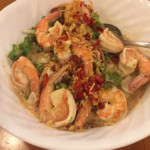Thai Winged Bean Salad
Before moving to Thailand approximately two months ago, I had neither seen nor heard of a winged bean. However, very quickly after our arrival, I started hearing about this curious vegetable. Winged beans look peculiar, but taste much like a regular green bean that you would find in Europe or the United States. In fact, unless you live in Thailand or South East Asia, you will most likely want to substitute green beans, snow peas or even asparagus for the winged beans. You might ask, “Why bother to post a recipe featuring a vegetable that is hard to find outside of South East Asia?” My answer is this, you simply must try this Thai winged bean salad! It’s combination of tart, spicy, salty, sweet flavors is divine! It is served warm so it’s a great dish to try this winter. It will be a treat for your taste buds and transport you to far off places. You will want to make it over and over. Give this winged bean salad a try. I think you will enjoy it as much as I do.
- Yield: 4-6 1x
- Category: Appetizer, Dinner, Lunch, Main Dish, Salad, Side Dish
- Cuisine: Asian, Thai
Ingredients
- 1/2 pound or 250 g winged beans, green beans, snow peas or asparagus (Trimmed)
- 2 tbsp toasted coconut (unsweetened)
- 1/4 cup peanuts or cashews (raw)
- 1/2 cups coconut milk (unsweetened)
- 2 tbsp lime juice (freshly squeezed)
- 2 tsp roasted red chili paste (use up to 1 1/2 tbsp if you like very spicy)
- 2 tbsp tamarind paste* (available in most specialty and Asian markets)
- 1 1/2 tbsp fish sauce
- 1 tsp coconut sugar
- 1/4 cups shallots (thinly sliced )
- 1/2 large red thai chili (thinly sliced (this chili is not spicy))
- 12 – 15 large fresh wild shrimp (peeled and cleaned tails on )
- 1/4–1/2 cup Avocado oil (for frying shallots and red chili)
Instructions
- Bring a large pot of salted water to a boil. Once the water is boiling, add the beans and let them boil for only 1 to 2 minutes. Remove the beans from the water and put the in a bowl of ice water to stop them from cooking.
- Once the beans are cooled, remove them from the water, slice them thinly and set them aside.
- Set a frying pan over medium-high heat, once the pan is hot add the peanuts or cashews keep them moving until they are starting to brown. Remove them from the pan. Once they are cooled, roughly chop the nuts and set them aside.
- In the same pan that you roasted the nuts, add the oil and heat it until it is hot. Add the sliced shallots and sliced chilies to the pan. Fry the shallots and chilies until the shallots are starting to brown. Using a slotted spoon, remove the shallots and chilies from the hot oil and let them drain on a plate that is covered with a paper towel to absorb any excess oil. Set the fried chilies and shallots aside.
- In a small sauce pan, set over medium heat, add the coconut milk and let it come to a simmer. Once the coconut milk is simmering, add the shrimp let them cook until they turn pink and are cooked through. Between 2 and 5 minutes depending on the size of the shrimp. Once the shrimp are cooked, remove the pan from the heat. Add the tamarind paste, coconut sugar, lime juice, fish sauce, nuts, and chili paste to the pot with the shrimp and stir.
- In a large serving bowl or deep plate, add the blanched winged beans, then add the shrimp and sauce to the serving dish. Top the shrimp with the fried shallots and chilies, the toasted coconut and serve immediately! This dish is best enjoyed warm.
Notes
- Tamarind paste and fish sauce are two common ingredients in Thai cooking, however they may be new to you. If so, please know that they are easily found at your local specialty market or Asian market. Some fish sauce has MSG in it so please make sure you purchase one without MSG. If mono-sodium glutamate (MSG) is not listed in the ingredients, check for “flavor enhancer” this is often used as a code word for MSG. When in doubt, ask.
- Tamarind paste often comes in a block that consists of the tamarind pulp and the seeds. This is great because it is close to its natural form. When measuring out the 2 tbsp of tamarind past, please avoid the seeds. You only want to put the pulp of the tamarind, not the seeds in the dish. The tamarind adds a wonderful tangy unique flavor to the dish that is characteristically South East Asian.
Thai Winged Bean Salad – Before moving to Thailand approximately two months ago, I had neither seen nor heard of a winged bean. However, very quickly after our arrival, I started hearing about this curious vegetable. Winged beans look peculiar, but taste much like a regular green bean that you would find in Europe or the United States. In fact, unless you live in Thailand or South East Asia, you will most likely want to substitute green beans, snow peas or even asparagus for the winged beans. You might ask, "Why bother to post a recipe featuring a vegetable that is hard to find outside of South East Asia?" My answer is this, you simply must try this Thai winged bean salad! It's combination of tart, spicy, salty, sweet flavors is divine! It is served warm so it's a great dish to try this winter. It will be a treat for your taste buds and transport you to far off places. You will want to make it over and over. Give this winged bean salad a try. I think you will enjoy it as much as I do. – winged beans, green beans, snow peas or asparagus (Trimmed), toasted coconut (unsweetened), peanuts or cashews (raw), coconut milk (unsweetened), lime juice (freshly squeezed), roasted red chili paste (use up to 1 1/2 tbsp if you like very spicy), tamarind paste* (available in most specialty and Asian markets), fish sauce, coconut sugar, shallots (thinly sliced ), large red thai chili (thinly sliced (this chili is not spicy)), large fresh wild shrimp (peeled and cleaned tails on ), Avocado oil (for frying shallots and red chili), , Bring a large pot of salted water to a boil. Once the water is boiling, add the beans and let them boil for only 1 to 2 minutes. Remove the beans from the water and put the in a bowl of ice water to stop them from cooking. ; Once the beans are cooled, remove them from the water, slice them thinly and set them aside. ; Set a frying pan over medium-high heat, once the pan is hot add the peanuts or cashews keep them moving until they are starting to brown. Remove them from the pan. Once they are cooled, roughly chop the nuts and set them aside. ; In the same pan that you roasted the nuts, add the oil and heat it until it is hot. Add the sliced shallots and sliced chilies to the pan. Fry the shallots and chilies until the shallots are starting to brown. Using a slotted spoon, remove the shallots and chilies from the hot oil and let them drain on a plate that is covered with a paper towel to absorb any excess oil. Set the fried chilies and shallots aside.; In a small sauce pan, set over medium heat, add the coconut milk and let it come to a simmer. Once the coconut milk is simmering, add the shrimp let them cook until they turn pink and are cooked through. Between 2 and 5 minutes depending on the size of the shrimp. Once the shrimp are cooked, remove the pan from the heat. Add the tamarind paste, coconut sugar, lime juice, fish sauce, nuts, and chili paste to the pot with the shrimp and stir. ; In a large serving bowl or deep plate, add the blanched winged beans, then add the shrimp and sauce to the serving dish. Top the shrimp with the fried shallots and chilies, the toasted coconut and serve immediately! This dish is best enjoyed warm. ; ; – <ul>
<li>Tamarind paste and fish sauce are two common ingredients in Thai cooking, however they may be new to you. If so, please know that they are easily found at your local specialty market or Asian market. Some fish sauce has MSG in it so please make sure you purchase one without MSG. If mono-sodium glutamate (MSG) is not listed in the ingredients, check for "flavor enhancer" this is often used as a code word for MSG. When in doubt, ask.</li>
<li>Tamarind paste often comes in a block that consists of the tamarind pulp and the seeds. This is great because it is close to its natural form. When measuring out the 2 tbsp of tamarind past, please avoid the seeds. You only want to put the pulp of the tamarind, not the seeds in the dish. The tamarind adds a wonderful tangy unique flavor to the dish that is characteristically South East Asian.</li>
</ul> – Appetizer – Dinner – Lunch – Main Dish – Salad – Side Dish – Asian – Thai – Dairy Free – Gluten Free – Healthy Comfort Food – Low Carb – Pescatarian – Eating Enchanted

